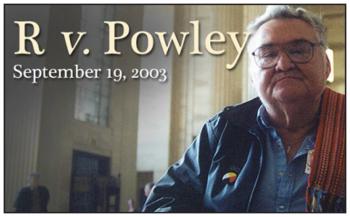Image Caption
Summary
Local Journalism Initiative Reporter
Windspeaker.com
Work has begun to commemorate the legacy of the Powley Case, one of the most important court decisions in the history of the Métis in Canada.
“I think it's important for all Métis communities because so much has been built by our government based on that victory in 2003,” said Mitch Case, Region 4 councillor on the Provisional Council of the Métis Nation of Ontario (MNO).
“We've used that tool to advance our harvesting rights from Ontario to Alberta. We've used that tool to bring (the federal) government to the table for self-government.”
The Powley case centred on father and son Steve and Roddy Powley. The pair shot a bull moose just outside of Sault Ste. Marie, Ont. in October 1993. They tagged the catch with a Métis card and note that read “harvesting my meat for winter.” They were charged with hunting a moose without a licence and unlawful possession.
Over the course of 10 years and under the guidance of legal counsel Jean Teillet, the case went all the way to the Supreme Court of Canada where, in September 2003, the judges unanimously upheld the findings of the three lower courts that the Powleys had an Aboriginal right to hunt as Métis and those rights were protected by Sect. 35 of the Constitution Act.
“The Court also spoke about the urgent need to develop more systemic methods to identify Métis rights-holders. In answer to government claims about the identification problems, the Court said that it was not an insurmountable problem and that the difficulties must not be exaggerated in order to defeat Métis claims,” wrote Teillet in a summary of the case.
And so the 10-point Powley test was created to define Sect. 35 Métis harvesting rights.
The Powley decision is part of what is often referred to as “the trifecta of Métis case law” that has moved Métis rights forward. That trifecta also includes the Manitoba Metis Federation decision (2013) that says Métis have outstanding land claims and the Daniels decision (2016) that puts Métis under federal government jurisdiction.
Steve Powley passed away in February 2004. He had been sick for a few years, said Case.
“For our community it's important because it all started here,” said Case, who represents Sault Ste. Marie on the provisional council.
Case is spearheading work on a permanent Powley exhibit with the 30 or more items he has in his possession. He feels strongly those items should belong to the community. He is formally educated as a historian, but says his interest is more than that.
“All of my work I focused on telling the story of my own community, just being a proud citizen here. But in that work I've spent a lot of time visiting with Elders, building that relationship,” he said.
Artifacts that recently came into Case’s possession include the sash Steve Powley wore at the Supreme Court and the flag that draped his casket.
Alongside Case’s personal collection will be documents, photographs and artifacts from the MNO and other Historic Sault Ste. Marie Métis Council members. The MNO has a “pretty substantial” collection of audio-visual material, including interviews.

Other items that will be included in the exhibit will be Steve Powley’s hat and hunting notebook, the rifle presented to Steve Powley by Manitoba Metis Federation President David Chartrand, the original copy of the Powley Decision, and the hide from the first moose “legally” harvested by the Métis community after the 2003 ruling.
Along with a permanent exhibit, the 20th anniversary of the Supreme Court decision will be marked with a travelling exhibit and a 30-minute documentary. All will launch on Sept. 19, 2023.
“The traveling exhibit is important just to connect communities, connect folks to that story. Essentially a generation has passed now since the victory. We know how important it is to tell our story,” said Case.
Nothing has been booked yet for the travelling exhibit, but Case says communities in Ontario and western Canada have expressed interest. He would also like to see the travelling exhibit visit non-Métis communities.
As for the 30-minute documentary, the work will be guided by Matt LeMay, the inaugural filmmaker-in-residence for Canadian Geographic. LeMay, an award-winning Métis filmmaker, claims the historic Métis community of Drummond Island as his ancestral home. He is a member of the MNO.
Case is hoping the documentary will be included with the travelling exhibit, as well as being available online.
The Powley commemoration has received $200,000 in federal funding from the Museum Assistance Program—Indigenous Heritage Grant. The program supports projects that preserve, manage, and present Indigenous cultural heritage. The work will be undertaken with support from Know History Inc.
The permanent exhibit will be housed in the new Sault Ste. Marie Métis Cultural Centre, which was once a church. The cultural centre is one of three buildings in the former St. John’s Anglican Church Complex which was gifted to the Sault Métis Council in 2017 by the Anglican Diocese.
“The language we've used around it is ‘tangible reconciliation.’ There's a lot of flowery words and nice talk when it comes to reconciliation. Where the rubber hits the road, that's sort of where things are lacking. I think the Anglican Church has shown some real leadership. They approached us. It wasn't a 20-year struggle of us fighting them,” said Case.
Over the years a relationship had been built with the diocese as the church had been built on Métis river lots and the grounds included graves from the old Métis settlement that had been dispersed in the late 1850s. Talks had been ongoing around recognizing the graves on the site.
When the diocese merged three of its parishes because of declining attendance, it offered the St. John’s complex to the Sault Métis Council.
“Several hundred thousand dollars” of renovations have just been completed on the rectory to turn it into a community hub where social, health and education programs will be offered, says Case. “Significant investment” from the Sault Métis Council’s own revenue, along with financial contributions from the city of Sault Ste. Marie and the province of Ontario paid for the renovations.
The Anglican Church operated the Shingwauk Indian Residential School in Sault Ste. Marie, that Indigenous children from Ontario, Quebec, the Prairies, and the Northwest Territories were forced to attend. The school operated from 1875 to 1970. Ground penetrating radar of the school site has just been completed and Case expects results to be known in the spring. He says records indicate about 100 students attending the school died, but there are no headstones on the grounds.
“There will be unmarked graves that are found, whether they correspond to the ones we know about or if there's more, would be a much more sinister discovery,” said Case.
Case said the Sault Métis Council is supporting the work that is being undertaken on the site guided by the Children of the Shingwauk Alumni Association, the survivors’ organization.
The former residential school was designated a national historic site in April 2021.
Local Journalism Initiative Reporters are supported by a financial contribution made by the Government of Canada.

